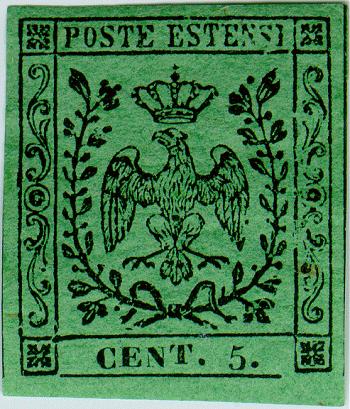
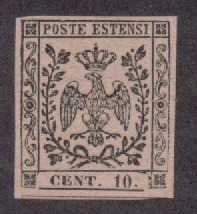
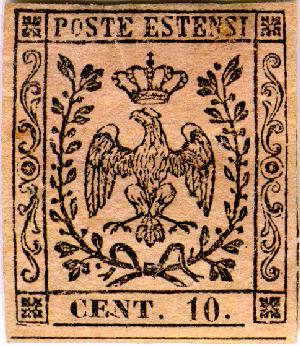
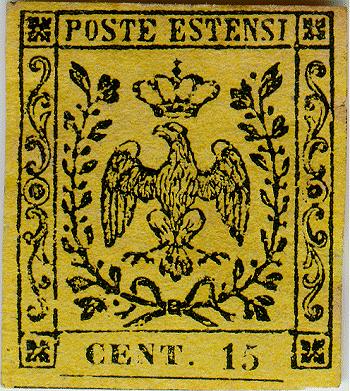
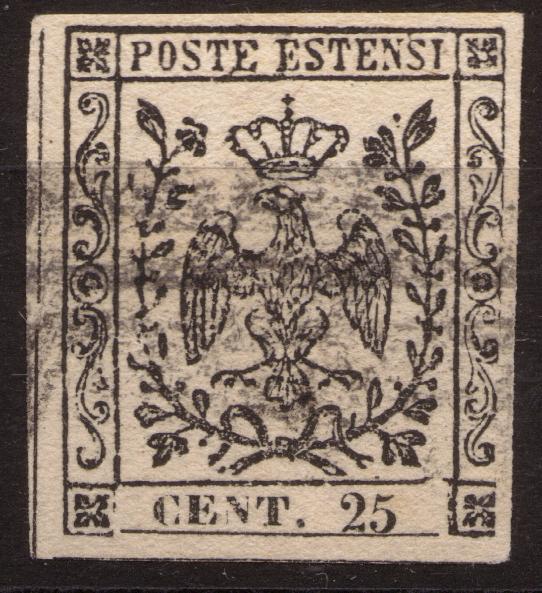
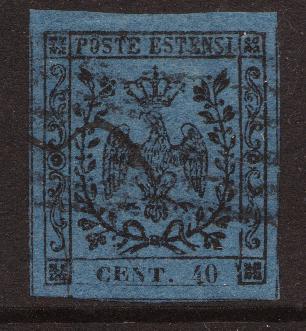
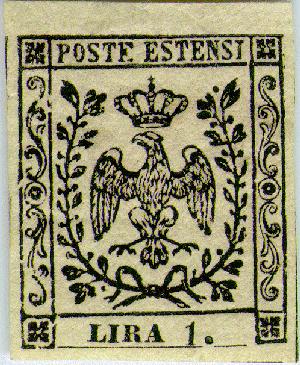
Return To Catalogue - Modena 1859 issues - Italy
Note: on my website many of the
pictures can not be seen! They are of course present in the cd's;
contact me if you want to purchase them: evert@klaseboer.com.
Currency: 100 Centesimi = 1 Lira.
With thanks to Lorenzo, (check his excellent website on Italian States!) who kindly set some of his images at my disposal.
Modena was a duchy in Italy. It was annexed by Sardinia in 1860.
5 c black on green 10 c black on red 15 c black on yellow 25 c black on brown 40 c black on blue 1 Lira black
B.G. 9 c black on violet (B.G.=Bollo Gazette=Newspaper stamp) 10 c black on violet (Newspaper stamp)
The 9 c stamp exist with 'B.G. CEN 9' in large size (first printing) and smaller sizes (see images above).
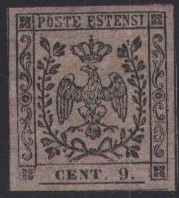
A 9 c black on violet exists without the 'B.G.', it is a stamp that was prepared but never been issued (due to a change in rate from 9 c to 10 c). It was sold to stamp collectors afterwards.
The 1 Lira is the only stamp with a watermark (large letter 'A'), all the other stamps have no watermark. This watermark can be found inverted or upside down.
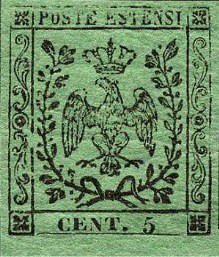

(Left variety without dot and right with dot)
For the specialist: the 5 c, 10 c and the 40 c have been issued with and without dot behind the value. The 15 c and 25 c only exist without dot behind the '15' and '25'. The 1 L has only been issued with dot behind the '1'. A numer of errors exists in the value label for all values (for example 'CNET.40'), they are all rare, examples:


('CENE 40' instead of 'CENT 40' and 10 c with lying 'N' in
'CENT')
Value of the stamps |
|||
vc = very common c = common * = not so common ** = uncommon |
*** = very uncommon R = rare RR = very rare RRR = extremely rare |
||
| Value | Unused | Used | Remarks |
| 5 c | *** | *** | |
| 9 c | RR | R | Newspaper stamp; With large 'BG': RRR |
| 9 c | * | - | No 'BG' (non issued stamp) |
| 10 c black on red | RR | R | |
| 10 c black on violet | *** | RR | Newspaper stamp |
| 15 c | *** | *** | |
| 25 c | *** | *** | |
| 40 c | R | R | |
| 1 L | R | RRR | |
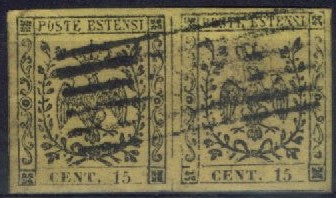
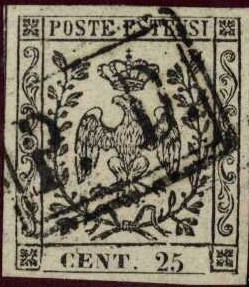
'Horizontal bars' cancel and 'P.D. in a box' cancel
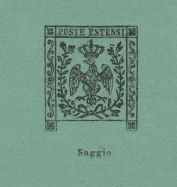
Could this be an essay? The bottom part is missing and the word
'Saggio' is added to the text (reduced size). I've also seen this
'essay' on other colors of paper (green, lilac, brown, yellow,
white). Some sources say that these are Usigli reprints (Usigli
was a printer who also reprinted Papal States stamps).
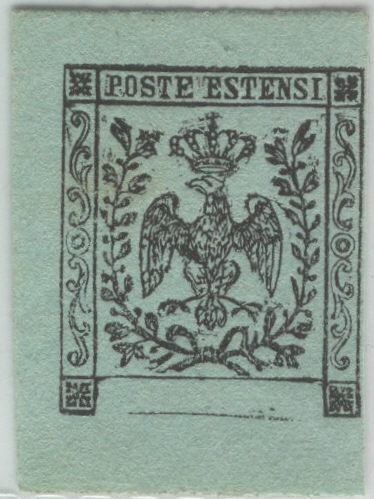
Another proof, probably from the same source. The eagle's head is
different from a genuine stamp. I've also seen these proofs on
yellow and grey paper.


(Genuine stamps, hole in right upper corner and lower corners)
Forgery detection: the line at the bottom of the stamp does not touch the ornaments on either side in the genuine stamps and furthermore the line under 'POSTE ESTENSI' does not touch the frame on the right hand side. The Fournier forgeries can be detected in this way (the lines are continuous), except for the 9 c newspaper stamp (which is forged in a better way). According to 'The forged stamps of all countries' by J.Dorn, the open corner in the right-hand upper inner frame, the dot over the right hand side leaves and the open pearl at the outermost left branch of the crown should be reliable characteristics of the genuine stamps.

Same forgery with more 'convincing' cancel
In the above Fournier forgeries the line at the bottom of the stamp is continuous. Furthermore the leaves at the left lower and upper corner are different from the genuine stamps. The cancel on the 1 L is on exactly the same location as in the image of the Fournier album of philatelic forgeries (it might have been printed with the stamp at the same time). Fournier offers these forgeries (all 6 values) for 1.50 Swiss Francs in his 1914 pricelist (as second choice forgeries). I have mostly seen it cancelled with horizontal bars or a circular cancel with 'MODENA' (no date). However, other more convincing cancels exist (see image above). I've also seen whole sheets of 25 stamps (5x5) with precancelled 'MODENA', a large 'PD' or 5 bars cancel (usually several different cancels in one sheet); very similar to the Spiro products (Fournier might have bought these Spiro forgeries and resold them as was quite common among forgers).
Fournier also offers a first choice forgery of the 9 c journal stamp (B.G. cen. 9) for 1 Swiss Franc in his 1914 pricelist. This forgery is much more deceptive than the above forgeries. I've seen the cancel 'MODENA 15 JUN 55' in a large circle in 'The Fournier album of philatelic forgeries' and on the stamp shown below. The line at the bottom of the stamp does not touch the ornaments on either side in these forgeries and furthermore the line under 'POSTE ESTENSI' does not touch the frame on the right hand side as in the genuine stamps. Also the 'B' has no left serifs and the 'G' of 'B.G.' is different.

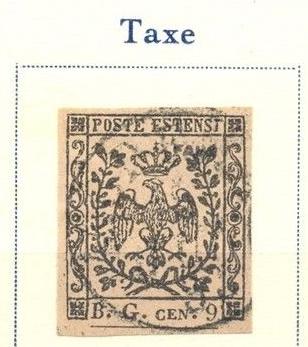
Fournier's second forgery; the second forgery does seem to have
serifs on the 'B' though (it was found in the Fournier Album of
Philatelic Forgeries)
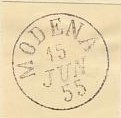
Forged Fournier cancel 'MODENA 15 JUN 55' in a single circle,
reduce size, taken from a Fournier Album
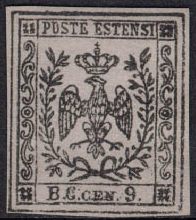


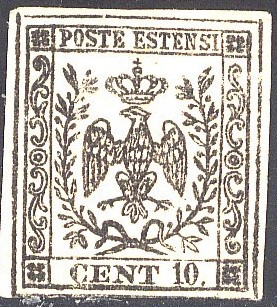

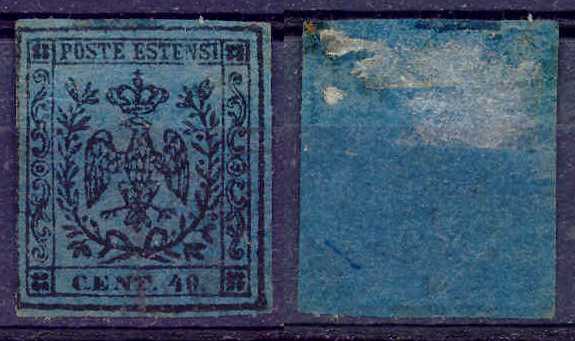
Note the different 'CENT 10' inscription in the 10 c values
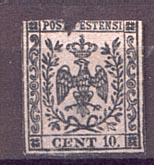
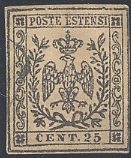
(Forgeries, reduced sizes, left with outside lines cut off)
In the above forgery (the third one described in Album Weeds) there is an extra outline all around the stamp, there are separating lines between the stamps in the genuine stamps, but not like the above forgery (see image below for comparison with genuine stamps). There are no open corners and no dot on the right hand side leaves. A further test for this forgery is that there are three rows of feathers very clearly visible on the chest of the eagle; arranged in two, three and three. I've also seen the 1 L of this forgery.
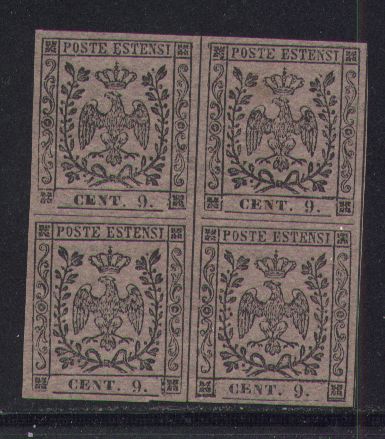
(Genuine stamps with separating lines for comparison)
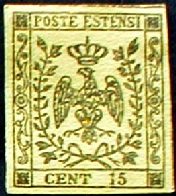
(in this forgery the line below the value is also closed)
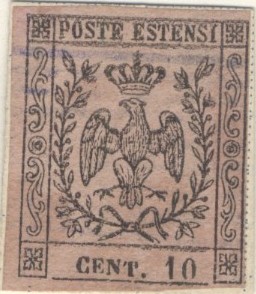
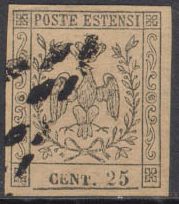

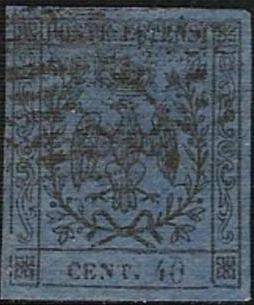
Forgeries, no open corner and no dot on the right hand side
leaves, also note the typical lower portion of the body of the
eagle. The circles on the left and right middle part do not touch
the ornaments below and above them. I've also seen the 5 c value
with a cancel consisting of parallel lines. The tail of the eagle
is too straigth. On http://forgeriesofitalianstates.com/Modena/Modena.htm,
the 15 c value of this particular forgery set can be found.
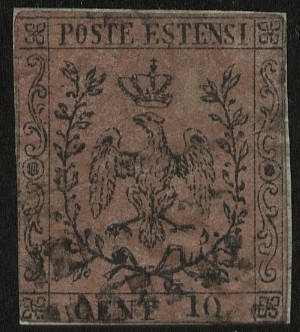
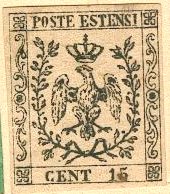

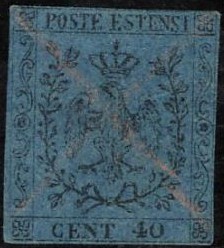
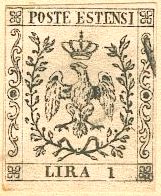
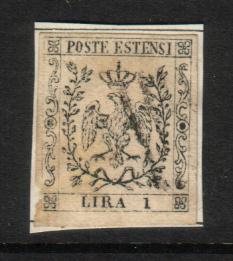
Crown and corner ornaments badly drawn, bottom frame line closed.
This type of forgery is often cancelled with a pattern of dots.
The beak of the eagle is too small and open.
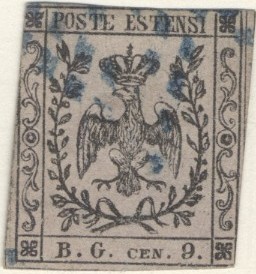
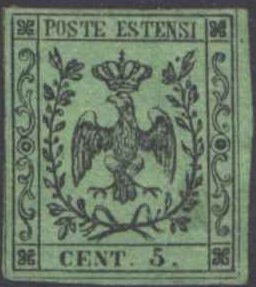
Two forgeries made by the same forger
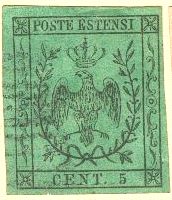

Primitive forgeries with totally different side patterns. I've
also seen the 15 c of this particular forgery type.
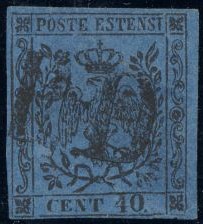

Forgery with large '40' and slightly different side ornaments.
Next to it a forgery of the 1 L with a bogus 'concentric circles'
cancel, made by the same forger. The 10 c value of this
particular forgery set also exists.
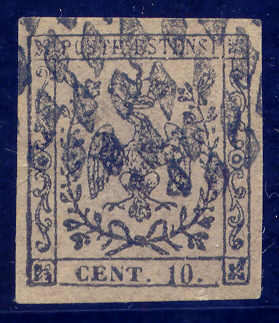
A forgery of the 10 c on thick paper with a bogus cancel

Forgery of the 9 c value; the crown touches the head of the
eagle. The leaf pattern is also different from a genuine stamp
(compare the upper left leaves with a genuine specimen).
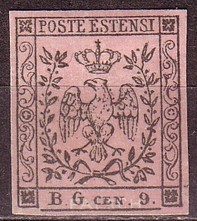
Modena 'BG CEN 9' black on red ('FALSCH' written in white on the
background at the bottom of the stamp); This forgery was given
away as an art supplement in one of Senf's
stamps journals. Note the detached leaves in the upper left part
of the stamp. I've seen this forgery with a black bars cancel
covering largely the word 'FALSCH'.
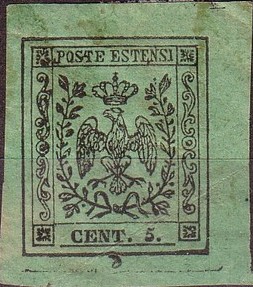
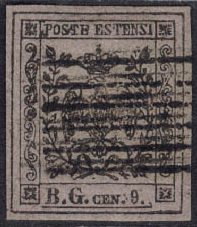
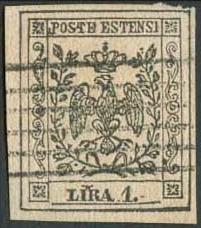
Forgeries with additional framelines, probably made by the same
forger. I've also seen the values 10 c and 25 c of this
particular forgery. The circle on the left hand central side is
too small. A similar forgery of the 40 c value can be found at http://forgeriesofitalianstates.com/Modena/Modena.htm.
I've been told that the next forgeries were made by a certain Mr. Martin of Treviso around 1930, they have no gum. I have no further information about these forgeries:

And another primitive forgery of the 25 c; the left wing is
touches the leaves below it. The eagle is sitting on somekind of
a stick. I've only seen the 25 c value of this particular
forgery. I've also seen it cancelled with a double ring town
cancel with unreadable name.
I have my doubts about the next copies, they are probably forgeries:
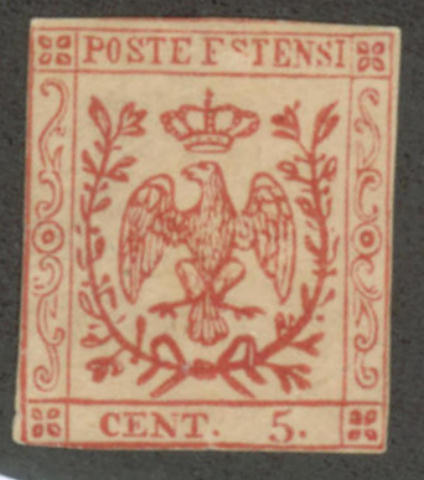
An unlisted 5 c red bogus issue! On http://forgeriesofitalianstates.com/Modena/Modena.htm,
the same forgery is shown but in black on yellowish. The head of
the eagle is quite different from the genuine stamp. This forgery
looks exactly the same as the illustration used in 'The Stamp
Collector's Handbook' of 1874 by Pemberton (page 71).
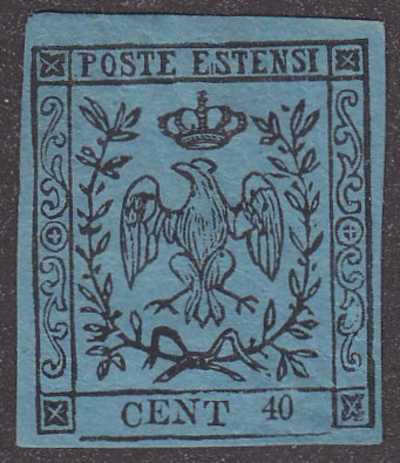
Primitive forgery of the 40 c value with the eagle totally
different from the genuine stamps.
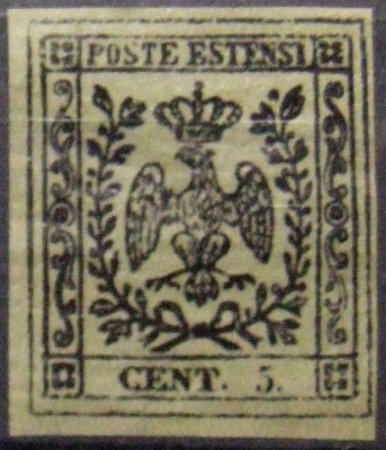
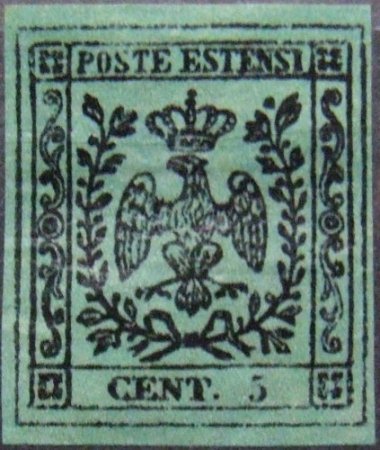
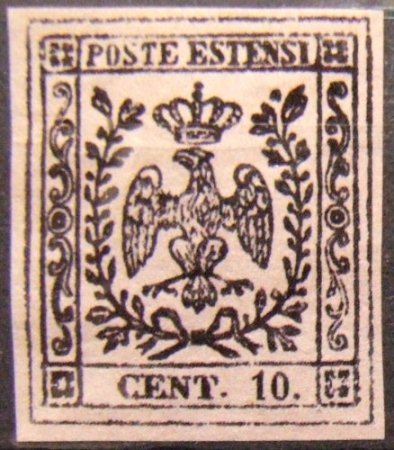


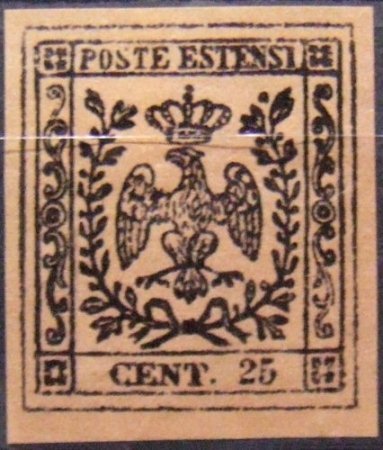
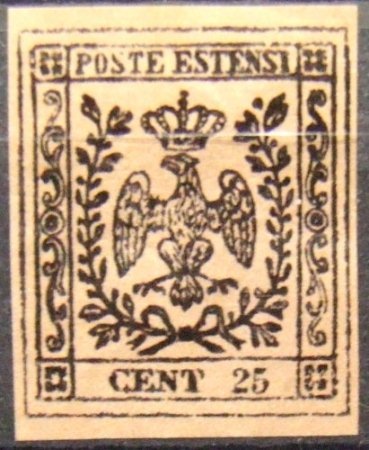

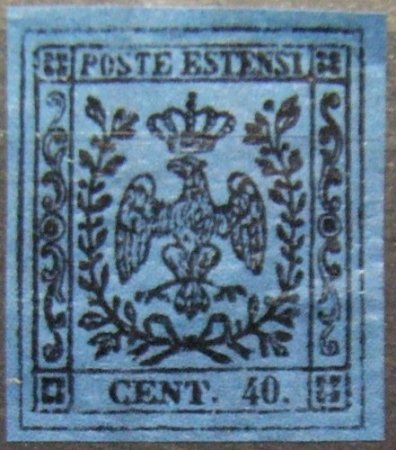
Forgeries made by the same forger

Very primitive forgery of the 1 L stamp.
The forger Sperati made a forgery of the 9 c large B.G. stamp. The forgery is lithographed.

Sperati forgery (proof); There is a hole in the upper frame above
the 'O' of 'POSTE' and the 'S's are badly shaped. The 'N' of
'CEN' is also badly done.
For the issues of Modena of 1859 click here.